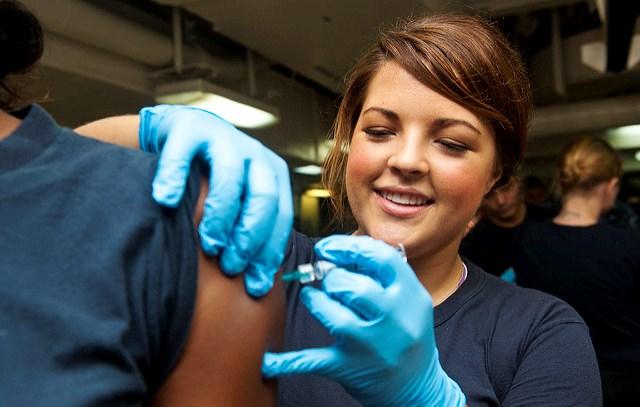In a multi-site case-control study conducted during the 2010-11 influenza season, flu vaccination lowered the risk of influenza-related hospitalization in people older than 50 by about 57%, an effect that held up even in those older than 74, according to a new report in Clinical Infectious Diseases.
The report notes that older people face an increased risk of flu complications, but evidence of flu vaccine effectiveness (VE) from randomized controlled trials is lacking for this population, and most observational studies have been limited by the use of nonspecific outcomes.
Eleven sites involved
The study, led by the Centers for Disease Control and Prevention (CDC), involved 11 hospitalization surveillance sites in the US Emerging Infections Program (EIP). Cases, identified through EIP surveillance, were defined as lab-confirmed flu in people at least 50 years old who were hospitalized in the 2010-11 season.
The researchers identified at least two community controls for each case-patient, matching them by age, county, and month of patient hospitalization. Participants' vaccination status was determined by self-reporting or medical records.
The team found that 55% of case-patients (205 of 368) had been vaccinated, versus 63% of controls (489 of 773). The case-patients were significantly more likely to be non-white and to have at least two chronic health conditions and an income less than $35,000, among other differences.
Little VE difference by age
After adjusting for several variables possibly associated with both flu risk and vaccination status (such as race, income, education, and health status), the authors estimated the overall VE at 56.8% (95% confidence interval [CI], 34.1%-71.7%). The adjusted VE varied relatively little by age-group: 50 to 64 years, 63.9% (95% CI, 12.0%-85.2%); 65 to 74 years, 61.0% (95% CI, 4.3%-84.1%); and 75 and older, 57.3% (95% CI, 15.9%-78.4%).
The finding that the age-group VE estimates were higher than the overall VE estimate reflects how statistical adjustments for possible confounding variables played out differently for the age-groups and for the overall sample, lead author Fiona Havers, MD, MHS, told CIDRAP News. She said the overall VE is not simply an average of the age-group VE estimates.
Havers, a medical officer in the CDC's Influenza Division, noted that the team included race, sex, smoking status, chronic health conditions, socioeconomic status, and other factors in the statistical models used to produce the VE estimates. "The impact of each of these factors on the vaccine effectiveness estimate is different in each age-group, and will lead to different effects on the VE estimates when all the subjects are analyzed together and when broken down into separate age-groups," she said.
"For example, in the overall adjusted VE estimate, the impact of having a chronic medical condition is factored in for all study subjects. However, when the study subjects are divided into age-groups, the effect of chronic medical conditions may be bigger in older versus younger age-groups versus the overall group."
Havers also observed that the confidence intervals for all the VE estimates overlap, adding, "Given that the range of possible values for each of the VE estimates overlap significantly, any differences between them are not particularly meaningful, and all of the estimates are actually quite similar."
The team also looked at VE by flu subtype. For influenza A/H3N2, adjusted VE was 51.3% (95% CI, 15.6%-71.9%), and for A/H1N1, of which there were relatively few cases, it was a nonsignificant 46.4% (95% CI, -117.3%-86.8%). VE was highest for influenza B at 94.7% (95% CI, 66.8%-99.2%). The report notes that the type B strain used in the vaccine matched well with circulating B strains in 201-11.
The authors said their results are similar to other estimates of VE during the 2010-11 flu season and consistent with VE estimates from observational hospital studies done during other seasons.
A more difficult method
The study differed from other recent observational VE studies involving hospital patients in that community controls were used, the researchers noted. Many recent observational studies have used the test-negative design, in which flu-negative patients identified in the same healthcare setting as flu patients are used as controls.
"Our results were comparable to studies of VE against influenza-associated hospitalization during 2010-11 that used a test-negative design, suggesting that use of community or hospitalized control groups can yield similar estimates," the researchers wrote. They added that finding and enrolling community controls was more costly and time-consuming than is identifying controls in a test-negative study.
The authors concluded that their findings suggest that even people 75 years and older benefit significantly from flu vaccination, underscoring the vaccine's importance for protecting older adults.
Havers FP, Sokolow L, Shay DK, et al. Case-control study of vaccine effectiveness in preventing laboratory-confirmed influenza hospitalizations in older adults, United States, 2010-11. Clin Infect Dis 2016 (published online Aug 2) [Abstract]





















